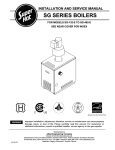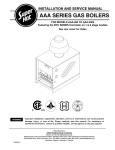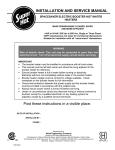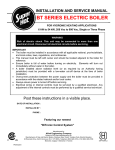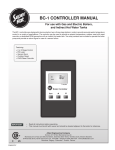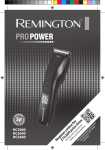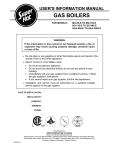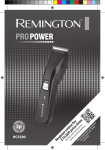Download Allied Engineering 6MSE Service manual
Transcript
INSTALLATION AND SERVICE MANUAL MINI-STAR® ELECTRIC BOILER Models 6MSE to 54MSE for Hydronic Heating 6 kW to 54 kW, 208 Vac to 600 Vac, Single or Three Phase WARNING Risk of electric shock. This unit may be connected to more than one electrical circuit. Turn off all electrical supply circuits before servicing. IMPORTANT • The boiler must be installed in accordance with all applicable national, provincial/state, and local codes, laws, regulations, and ordinances. • This manual must be left with owner and should be located adjacent to the boiler for reference. • Ensure boiler is full of water before turning on electricity. Elements will burn out immediately without water in the boiler. • A boiler installed above radiation level (or as required by an Authority having jurisdiction) must be provided with a low-water cut-off device at the time of boiler installation. • Overcurrent protection between the power supply and the boiler must be provided in accordance with the related national and/or local codes. • Always ensure power is turned off before servicing. • Electrical wiring or internal controls must be serviced by a qualified electrician. Any adjustment of the internal controls must be performed by a qualified service technician. Post these instructions in a visible place. DATE OF INSTALLATION : INSTALLED BY : PHONE : Featuring the BC-1 Controller with Outdoor Reset and DHW Override Manufactured by Allied Engineering Company Division of E-Z-Rect Manufacturing Ltd. Manufacturers of Gas and Electric Boilers, Heat Exchangers, Electric Boosters, Indirect Tanks 94 Riverside Drive, North Vancouver, B.C. V7H 2M6 • Telephone 604-929-1214 • www.alliedboilers.com Branches: Calgary • Edmonton • Toronto • Denver PN4330651 (OPTIONAL) MSE Series Electric Boilers – Installation and Service Manual Dimensions and Specifications 1.1 Section 1 TECHNICAL SPECIFICATIONS Maximum Operating Pressure: Maximum Operating Water Temperature: Water Capacity in Boiler: Inlet and Outlet Pipe Size: Controller Pump Switch Capacity: 90 p.s.i. 210ºF 6.6 US Gallons 1 1/4” NPT 5A Maximum Table 1: Super Hot MSE Series Electric Boiler Specifications. (Flange Type Elements) Super Hot MSE Series Electric Boilers Single Phase Three Phase 208 Vac 240 Vac 208 Vac 240 Vac 480 Vac 600 Vac Model kW Btu/Hr Amp Amp Amp Amp Amp Amp 6MSE 6 20,474 28.9 25.0 16.7 14.4 7.2 5.8 9MSE 9 30,708 43.3 37.5 25.0 21.6 10.8 8.7 12MSE 12 40,848 57.7 50.0 33.3 28.8 14.4 11.5 15MSE 15 51,185 72.1 62.5 41.6 36.0 18.0 14.4 18MSE 18 61,422 86.5 75.0 54.6* 47.3* 23.7* 18.9* 20MSE 20 68,240 96.2 84.3 63.6* 55.1* 27.6* 22.0* 24MSE 24 81,895 115 100 66.5 57.7 28.8 23.1 27MSE 27 92,124 130 113 74.9 64.9 32.4 26.0 30MSE 30 102,369 144 125 83.2 72.1 36.0 28.8 34MSE 34 116,008 164 142 100* 87.0* 43.5* 34.8* 38MSE 38 129,656 183 158 118* 102* 50.5* 40.4* 42MSE 42 143,304 202 175 116 101 50.5 40.4 45MSE 45 153,540 216 188 125 108 57.7* 46.2* 48MSE 48 163,776 231 200 138* 119* 59.6* 47.7* 54MSE 54 184,248 260 225 150 130 64.9 52.0 Note: 1. 2. 3. Other models of the MSE Series Electric Boiler may be available subject to inquiry. * Delta connection (unbalanced load) amperage of high leg indicated. Approximate shipping weights: Model Ŧ Weight 6MSE & 9MSE 114 lb 12MSE to 18MSE 116 lb 20MSE & 24MSE 118 lb 27MSE to 38MSE 122 lb 42MSE to 54MSE 126 lb Ŧ Add 45 lb for package models 2 MSE Series Electric Boilers – Installation and Service Manual 1.2 WATER TEMPERATURE RISE vs FLOW RATE NOTE: The boiler should be properly sized for its heating application and maintain an adequate water flow rate during operation. Significantly oversizing the boiler or decreasing boiler water flow rate will cause excessive stage cycling and result in premature failure of the contactors. Water flow rate vs temperature rise formulas in US gallons per minute (GPM) and liters per minute (LPM): 6.94 x kW Temp. Rise (°F) GPM = LPM = 14.6 x kW Temp. Rise (°C) Table 2: Water Temperature Rise vs Flow Rate in GPM (LPM) 1.3 Model KW 10°°F (5.6°°C) 20°°F (11°°C) 30°°F (17°°C) 40°°F (22°°C) 6MSE 6 4.2 (16) 2.1 (8) 1.4 (5) 1.0 (4) 9MSE 9 6.2 (23) 3.1 (12) 2.1 (8) 1.6 (6) 12MSE 12 8.3 (31) 4.2 (16) 2.8 (10) 2.1 (8) 15MSE 15 10.4 (39) 5.2 (20) 3.5 (13) 2.6 (10) 18MSE 18 12.5 (47) 6.2 (24) 4.2 (15) 3.1 (12) 20MSE 20 13.9 (52) 6.9 (27) 4.6 (17) 3.5 (13) 24MSE 24 16.6 (63) 8.3 (32) 5.5 (21) 4.2 (16) 27MSE 27 18.7 (70) 9.4 (36) 6.2 (23) 4.7 (18) 30MSE 30 20.8 (78) 10.4 (40) 6.9 (26) 5.2 (20) 34MSE 34 23.6 (89) 11.8 (45) 7.9 (29) 5.9 (23) 38MSE 38 26.4 (99) 13.2 (50) 8.8 (33) 6.6 (25) 42MSE 42 29.1 (109) 14.6 (56) 9.7 (36) 7.3 (28) 45MSE 45 31.2 (117) 15.6 (60) 10.4 (39) 7.8 (30) 48MSE 48 33.3 (125) 16.6 (64) 11.1 (41) 8.3 (32) 54MSE 54 37.5 (141) 18.7 (72) 12.5 (46) 9.4 (36) GENERAL DIMENSIONS Figure 1 – General Dimensions 3 MSE Series Electric Boilers – Installation and Service Manual Installation Instructions 2.1 Section 2 RECEIVING INSPECT SHIPMENT FOR POSSIBLE DAMAGE. All goods are carefully manufactured, inspected, checked and packed by experienced workers. The manufacturer's responsibility ceases upon delivery of goods to the carrier in good condition. Any claims for damage, shortage in shipment or non-delivery must be filed immediately against the carrier by the consignee. 2.2 INTRODUCTION ® The Super Hot Mini-Star Electric Boiler provides convenient and comfortable hydronic heating for closed loop systems in both residential and commercial applications. It is controlled by the BC-1 controller which regulates the boiler water temperature using three stages, switching stages on or off based on heating demand, PID (proportional, integral, differential) logic, and user-defined water temperature settings. The controller is capable of controlling a 120 Vac circulating pump (rated up to 5A or 600VA) which activates when there is a thermostat or DHW call for heat. Using three stages to regulate the boiler water temperature has advantages over conventional on/off single stage boilers. Instead of switching all heating elements on or off using sequencers, the BC-1 controls each stage directly to minimize temperature fluctuations, avoid surges in line current, and reduce the number of on/off operations of the contactors and heating elements. Because the average “on/off cycle” of each of the heating elements is greatly decreased, this ensures better temperature stability, extends the life of the components and increases energy efficiency. With the addition of an Outdoor Sensor to the BC-1 controller, “Outdoor Reset” can be used to increase or decrease outlet water temperature based on changing outdoor air temperatures. This feature helps reduce temperature swings and allows the boiler output to more closely match the actual heating load. 2.3 BOILER LOCATION The boiler is intended for indoor installation only and must not be subjected to water spray or leakage. It may be installed in an enclosed space and attached directly to a combustible surface. Allow ample space around the boiler to ensure all connections and controls are readily accessible. The minimum required clearances for service are shown in the following table: Minimum Clearance left side = 18 inches right side = 12 inches front = 12 inches top = 10 inches bottom = 10 inches Provides service access for elements plumbing connections electrical components and fuses screws for front casing panel screws for front casing panel (458 mm) (305 mm) (305 mm) (254 mm) (254 mm) It may be preferable to locate the boiler close to the electrical supply panel. Protection from Liquids The controller and other components located within the control panel are sensitive to water and other liquids. Measures must be taken to fully protect components on the control panel from contact with liquids. This especially applies to overhead pipes which may leak, burst or drip condensate and cause damage. 4 MSE Series Electric Boilers – Installation and Service Manual 2.4 WALL MOUNTING CAUTION: Failure to correctly position the boiler may result in element burn out. For example, installing the boiler with the front casing panel facing upwards will result in element burn out. This boiler must be installed using the attached wall mounting brackets. It is critical that the boiler be installed level and oriented as shown in Figure 2 (below). When correctly positioned, the front panel is vertical and the 1 1/4”NPT outlet connection is directly above the 1 1/4”NPT inlet connection. The wall mounting brackets on the boiler feature a “key-hole” opening suitable to fit over the head of two previously installed 5/16” lag screws. The key-hole openings are located on 16” centers (i.e. standard stud spacing) on the top side of the hangers. The lag screws must be suitably anchored to safely support the weight of the boiler including water content, piping and wiring. 2.5 PIPING The BC-1 controller includes six operation modes to handle various piping arrangements and applications as specified in the BC-1 Controller Manual. The operation mode of the controller must be correctly selected to match the piping arrangement. A typical parallel piping arrangement is shown below in Figure 2. Attach pump, expansion tank, drain valve, pressure relief valve, air vent, pressure temperature gauge and flow switch (as required). Air vents should be installed at points just upstream from all drops in elevation of the piping system (high points). A boiler installed above radiation level, or as required by an authority having jurisdiction, must be provided with a low-water cut-off device at the time of boiler installation. Figure 2 – Piping Arrangement 5 MSE Series Electric Boilers – Installation and Service Manual 2.6 SYSTEM OPERATING REQUIREMENTS MSE series electric boilers are designed for use in closed loop hydronic systems and are not intended for open systems, such as domestic hot water and pools, where water is continually replenished. Operating the boiler in an open system will result in premature failure due to corrosion of the boiler. Electric boilers may be used to heat water in open systems indirectly by installing a heat exchanger, such as the Super Hot C-coil or Indirect Tank, to separate open and closed systems. Avoid unnecessary replenishment of system water. It can allow oxygen to enter the system and cause serious corrosion problems. As well, minerals dissolved in the water supply will precipitate when heated, thus preferentially depositing in the boiler. The use of oxygen barrier piping is strongly recommended to protect the system and its components from corrosion. Chemical inhibitors are not recommended as their improper use or maintenance can cause accelerated corrosion, and premature failure of the boiler tank and its components. If your system includes “non-oxygen barrier tubing”, please contact the factory of your heating professional for recommendations. Corrosion is a preventable condition and therefore failure due to corrosion is not covered by the Super Hot product warranty. MSE series electric boilers must always be used with forced system circulation. 6 MSE Series Electric Boilers – Installation and Service Manual Wiring 3.1 Section 3 ELECTRICAL WIRING All electrical wiring must be done in accordance with the Canadian Electrical Code, CSA C22.1 Part 1, and/or any local regulations and codes in Canada, or the National Electrical code, ANSI/NFPA 70 (latest edition) and/or any local regulations and codes in U.S.A.. Verify the nameplate rating and check the related codes to properly size conductors, switches and overcurrent protection. Several openings are provided on the right and bottom of the casing for different voltage connections. For wire connections refer to the wiring diagram sticker on the back of the boiler front casing panel. WARNING – Risk of Electric Shock: Disconnect all electrical power before installation or service! All circuit breakers ahead of and at the boiler must be OFF. Remove the boiler front casing panel by removing the screws at the top and bottom. a. Wiring on Controller Figure 3 - Terminal blocks 7 MSE Series Electric Boilers – Installation and Service Manual Electrical Connections For all electrical connections: Strip wire ends and insert into the terminal block. Tighten terminal screw clamps to securely hold the wire. CAUTION - Risk of damage to the controller: Do not apply power to any connections on Terminal Block TB4 or TB5, except L1 & L2. Terminal Block Connections Name Description / Comments TB5 L1 & L2 Line Voltage If L1 and L2 are not pre-wired, connect only 120 Vac, 60 Hz, single phase power to terminals L1 (Hot) and L2 (Neutral) of terminal block TB5. P1 & P2 Pump Connect only 120 Vac, maximum 1/6 HP pump to terminals P1 and P2 of the terminal block TB5. If a pump horsepower larger than 1/6 HP is used, change the pump fuse on the boiler based on the pump rating. Do not use a pump requiring greater than 5A or 600 VA. HL & HL High Limits Pre-wired (factory wiring). Two temperature high-limits (set at 239°F with automatic reset) are connected in series to terminals HL and HL. BO & CM Boiler Outlet Sensor Pre-wired (factory wiring). Connect outlet water temperature sensor to terminals BO and CM (common). The Boiler Outlet Sensor is inserted into the thermowell on the right side of the tank beside the boiler outlet. BI & CM Boiler Inlet Sensor Connect inlet water temperature sensor to terminals BI and CM (common). The Boiler Inlet Sensor is attached by cable tie to the boiler inlet pipe. OS & CM Outdoor Sensor Optional Outdoor Sensor (for Operation Mode 4 only): Connect Outdoor Sensor 070 to terminals OS and CM (common). The Outdoor Sensor is installed on an exterior wall, typically facing North, and above the snow line. It should be shielded from effects of heat or cold to prevent false outdoor temperature readings. Avoid direct sunlight, exhaust fans, appliance vents, and excessive moisture. SD & CM Supply/DHW Sensor Optional (for Operation Mode 3 only). Connect a Supply/DHW Sensor 071 to terminals SD and CM (common). The Supply/DHW sensor is inserted into a thermowell on the DHW tank or attached by cable tie to the supply pipe. AL & AL Alarm Optional. The alarm contacts are a powered output, do not apply power. Connect an alarm (beeper, light, or relay) with a rating of 24 Vac and maximum 0.45 A to terminals AL and AL. FS & FS Flow Switch Optional. Remove the jumper from the terminals FS and FS. Connect flow switch to terminals FS and FS. Do not apply power. ST & R Setpoint DHW Demand Optional Domestic Hot Water Aquastat (for Operation Mode 4 only): Connect domestic hot water aquastat to terminals ST and R. Closed is activation. Do not apply power. HT & R Heat Demand Connect Thermostat or Zone Valve End Switch to terminals HT and R. Closed is activation. Do not apply power. TB4 8 MSE Series Electric Boilers – Installation and Service Manual b. Power Supply to Heaters The supply cable has to be sized based on the amperage in Table 1 and the cables used. Connect only specified line voltage and phase power to main terminal block on the control panel. Strip wire ends before inserting into terminal block. Tighten terminal screw clamps. Attach ground wire to ground terminal block on the control panel. Startup Instructions 4.1 Section 4 WARNING WARNING The following instructions are intended as a guide for a Qualified Service Technician. Before switching the power on, fill the system with water and vent air. Check for and repair any leaks in the water piping. 4.2 a. STARTUP Fill System Figure 2 shows the suggested set-up for a make-up water supply using a pressure regulator (supplied with “PS” package). Do not apply full line make-up water pressure to the system. Fill the system to approximately 12 psi (cold water) if the expansion tank is pressurized at 12 psi. The expansion tank should be sized to provide the system with enough volume for thermal expansion and contraction while maintaining operating pressures within safe and reasonable limits. There should be no significant pressure fluctuations in systems having both an effective automatic fill valve and a properly sized expansion tank or expansion tank arrangement. The standard pressure relief valve supplied with the boiler is rated at 30 psi, or as required by order, but the maximum working pressure cannot exceed 90 psi for the electric boiler. Once the system is filled with water, all trapped air must be removed to avoid air locks, which can reduce flow rate and cause thermal shock. Figure 2 also illustrates the connections to the air purger (not supplied by manufacturer) and expansion tank in the line from the boiler to the radiation units. Additional air purgers should be installed at high points in the system to assist in removing air which can accumulate from the water supply line. All high points must be vented. b. Startup Procedure Perform the following procedure as a check for proper boiler and system operation: 1. Press and hold three keys found below the LCD screen of the controller until “Adjust” is displayed (Figure 5). In adjust mode, enter the desired settings for your heating application (see BC-1 Boiler Controller Manual for more information). (Note: This boiler is also equipped with a non-adjustable, high-limit temperature device set at 239°F as safety limit control. The high limit temperature device has an automatic reset function.) 2. Turn up all room thermostats above room temperature. 3. When power is supplied to the controller, the LCD displays “- - -“. When the thermostat calls for heat, the pump will be energized immediately and the pump indicator, , will display on the LCD. The “- - -“ screen is replaced with the boiler target temperature. Next, the three stages are energized along with the stage indicator, , in sequence and based on the user settings. Once the boiler water temperature reaches the setpoint, the controller will regulate the boiler water temperature using the three stages. The number of stages that switch on is based on the heating demand and user settings. After all room thermostats are satisfied, the controller de-energizes the three stages, in sequence, and then switches off the pump. 4. Current must be checked by a qualified electrician at the feeder panel and compared to the values shown in Table 1. 5. Turn thermostats to the desired room temperature. 9 MSE Series Electric Boilers – Installation and Service Manual BC-1 Controller Information Section 5 WARNING The following section is intended as a quick reference guide for the BC-1 Controller Manual. Read all instructions and the BC-1 Controller Manual before placing the boiler in operation or making any adjustments. Adjustments must be made by a qualified heating technician. 5.1 CONTROLLER INFORMATION Control Board Dimensions: 4-3/4” (L) x 2-7/8” (W) x 1-7/8” (H). Power Outputs: Pump output from P1 P2 terminals on the pump terminal block is 120 Vac, 60 Hz, 5 A max. These terminals can provide an automatic on/off switching power supply to the boiler pump or a pump contactor. The load current of this output is limited by the pump fuse selected (boiler supplied with 3 A fuse) and must not exceed 5 A or 600 VA. Boiler Stage outputs from Stg1&Stg1, Stg2&Stg2 and Stg3&Stg3 terminals are 24 Vac, 60 Hz. Alarm output from AL&AL terminals is 24 Vac, 60 Hz, 0.45 A maximum. Signal Inputs/Controls (Do not apply external power): HT&R: Figure 4 – BC-1 Controller Room thermostat or zone valve end switch, 24Vac switching input, closed is activation. ST&R: Setpoint DHW aquastat, 24Vac switching input, closed is activation. FS&FS: Flow switch, 24Vac switching input, closed is activation. HL&HL: High Limits, 24Vac switching input, open at 239°F, automatic reset. Thermistor Sensors BO&CM: Boiler outlet sensor BI&CM: Boiler inlet sensor OS&CM: Outdoor sensor SD&CM: Supply / DHW sensor 10 MSE Series Electric Boilers – Installation and Service Manual 5.2 CONTROLLER DISPLAY The BC1 uses a Liquid Crystal Display (LCD) as a method of supplying information. You use the LCD in order to setup and monitor the operation of your system. The BC-1 uses three push buttons (Item, ▲, ▼) for selecting and adjusting settings. As you program your control, record your settings for future reference. Figure 5 - BC1 Controller LCD Display Menu All of the items displayed by the control are organized into two menus. These menus are listed on the upper right hand side of the display (Menu Field). The default menu for the BC-1 is the View menu. While in the View menu, the VIEW segment is displayed. To select the Adjust menu, press and hold simultaneously all three buttons for 1 second. The display then advances to the Adjust menu and the ADJUST segment is turned on in the display. The display will automatically revert back to the View menu after 20 seconds of keypad inactivity. Once in a menu, there will be a group of items that can be viewed within that menu. Item The abbreviated name of the selected item will be displayed in the item field of the display. To view the next available item, press and release the Item button. Once you have reached the last available item in a menu, pressing and releasing the Item button will return the display to the first item in the selected menu. Adjust To make an adjustment to a setting in the control, begin by selecting the Adjust menu by pressing and holding simultaneously all three buttons. Then select the desired item using the Item button. Finally, use the ▲ or ▼ button to make the adjustment. 11 MSE Series Electric Boilers – Installation and Service Manual Summary of BC-1 Display Text in Installer Mode VIEW MENU Display Text in Mode Description OUTDR 4,5 BOIL TARGET 1,2,3,4,5 Target boiler supply temperature the control is trying to maintain at the boiler supply sensor or the boiler outlet sensor BOIL SUP 2,5 Current boiler supply water temperature as measured by the boiler supply sensor. BOIL OUT 1,3,4,6 Current boiler outlet water temperature as measured by the boiler outlet sensor BOIL IN All Current boiler inlet water temperature as measured by the boiler inlet sensor. BOIL ∆T All Current T (temperature difference) between the boiler outlet sensor and the boiler inlet sensor TANK 3 Current DHW tank temperature as measured by the DHW sensor. BOIL ON All The total number of running hours of the boiler since this item was last cleared Display Text Default Description MODE 1 Sets the operating mode for the control. The following modes are recommended for the Super Hot Electric Boiler: Mode 1 (parallel piping, setpoint heating); Mode 3 (parallel piping, dedicated DHW generation only), Mode 4 (parallel piping, outdoor reset with optional DHW override). BOIL TARGET 180°F Minimum boiler target temperature during reset override, setpoint or DHW operation. TANK TARGET 140°F Sets the DHW storage tank’s temperature. Used in Mode 3 only. TANK DIFF 5°F Sets the differential for the DHW storage tank. OUTDR START 70°F The outdoor starting temperature used in the reset ratio for the heating system. OUTDR DSGN 25°F The design outdoor air temperature used in the heat loss calculations for the heating system. BOIL START 70°F The starting water temperature used in the reset ratio calculation for the heating system. BOIL DSGN 180°F The design water temperature used in the heat loss calculations for the heating system. BOIL MAX 210°F The maximum boiler target water temperature. BOIL MASS 2 DIFF 20°F Outdoor air temperature measured by outdoor sensor ADJUST MENU DLY 0:30 min WWSD 70°F °F / °C °F The thermal mass of the boiler used. Always use 2 for the Super Hot Electric Boiler. The differential that the control is to use when it is operating the boiler. Determines when to stop purging the pump. The system’s warm weather shut down. The units of measure that all of the temperatures are to be displayed in by the control. 12 MSE Series Electric Boilers – Installation and Service Manual 5.3 CONTROLLER OPERATION When the controller is powered, the controller enters the operating mode if there are no sensor or high limit errors present. The user should select one of the following modes from the controller adjust menu: Mode 1 - Setpoint operation: Operates boiler stages to maintain fixed temperature at boiler outlet sensor when a heat demand is present. Mode 3 - Dedicated DHW Generation: Operates boiler stages to maintain tank temperature at the SD sensor. An indirect hot water tank must be used. Mode 4 - Outdoor reset with reset override: operates stages to maintain an outdoor reset temperature at the boiler outlet sensor. When there is a call for “reset override” from the DHW aquastat (i.e. ST&R is closed), the control operates the stages to maintain a setpoint temperature at the boiler outlet sensor. If both heat demand and setpoint DHW demand are present at the same time, the controller targets the higher of the two requirements. When there is a heat demand or DHW demand the controller will switch on the system pump. If the sensor is not satisfied, the controller will switch on additional stage(s), in sequence, and based on PID (proportional, integral, derivative) logic. The controller continuously monitors the sensors and examines the difference between the target temperature and the sensor temperature. Depending on the difference in temperature (proportional), the time (integral), and how fast or slow the temperature is changing (derivative), it will determine when to switch a stage on or off. This feature prevents "short cycling", which can quickly wear out contactors and cause rapid temperature fluctuations. The heating routine will operate until the water temperature reaches the user-defined temperature setting. Once reached, the control will automatically cycle the stage(s) of the boiler on or off, as necessary, to maintain the supply water temperature. The required number of stages which are activated is determined by the controller. After the call for heat has been satisfied, the stage(s) of the boiler will switch off, in sequence, followed by the pump. 5.4 RESET OVERRIDE WARNING If both Heat Demand and Setpoint DHW Demand are present at the same time, the controller targets the higher temperature of the two requirements. This may result in higher than intended water temperatures in either space heating loop or domestic hot water (DHW) heating loop. Use pipe rated for use at the highest possible water temperature. The BC-1 Controller has one pump relay which is normally open and will close (i.e. pump energized) when either a Heat Demand or Setpoint DHW Demand is present. When using Reset Override, a switching external pump relay (e.g. tekmar Relay 003) should be utilized to stop hot water flow to the space heating loop (e.g. radiant in-floor) and redirect it to the DHW heating loop during a Setpoint DHW Demand. See Figure 6 and Figure 7. MODE 4 ONLY (Outdoor reset and reset override) T1 M T1 A1 M Pump 2 S1 S1 = Boiler Outlet Sensor 071 S2 = Boiler Inlet Sensor 071 Pump1 = Boiler Pump Pump2 = DHW Pump A1 = DHW Aquastat T1 = Thermostat Pump 1 S2 Figure 6 – Typical piping arrangement of system components in Mode 4 13 MSE Series Electric Boilers – Installation and Service Manual Sequence of Operation Thermostat (T1) closed - Thermostat creates a Heat Demand resulting in a boiler target based on the outdoor reset settings. The boiler pump (Pump1) operates. DHW Aquastat (A1) closed - DHW Aquastat creates Setpoint DHW Demand and activates external pump relay. The external pump relay causes the following actions: 1) Power for the boiler pump (Pump1) is broken. Pump1 does not operate. 2) Power for the DHW pump (Pump2) is made. Pump2 operates. 3) Setpoint DHW Demand creates a boiler target based on the higher requirement of the outdoor reset and reset override setting. L1 L2 P1 Pump 2 P2 t ekmar Rel ay 003 A1 Pump 1 C 1 HT ST 2 3 R FS FS 4 5 6 External Class II Transformer 24V T1 120V(ac) C R L N Figure 7 – Wiring diagram illustrating use of an External Relay to control pump operation 5.5 CONTROLLER MOUNTING The BC-1 controller mounts on the controller mounting plate in the control chamber using a sheet metal screw. The LCD and buttons should visible and accessible from the front of the boiler casing. To remove the controller: 1.) remove the front casing panel, 2.) pull off the black plastic top cover of the controller, 3.) unscrew the sheet metal screw, 4.) lift the controller slightly out of the rectangular cutout in the mounting plate, 5.) pull off the Molex connector while simultaneously holding down the tab on the left side. 14 MSE Series Electric Boilers – Installation and Service Manual Maintenance Instructions 6.1 Section 6 SERVICE HINTS a. This boiler has been designed to provide years of trouble free performance under normal operating conditions. However, the owner should conduct a general external examination at the beginning of each heating season and at mid-heating season to assure good working performance is continued. In addition, a qualified service technician should examine the boiler at least once every year. b. Do not store anything against the boiler or allow dirt or debris to accumulate in the area immediately surrounding the boiler. c. Elements will burn out if the boiler is not filled with water when electrical power is turned on. Do not connect thermostat wires until system has been filled with water. Water should be drained out from system only when absolutely necessary to make repairs or prevent freeze-up during extended cold weather shutdown. d. The pressure & temperature gauge on the system should be checked frequently. During normal operating conditions, pressure should be relatively stable throughout the heating season. If pressure under normal operating conditions consistently rises and falls over a period of time, this can indicate a fill valve leak, system leak or expansion tank malfunction. Leaks anywhere in the system must be repaired without delay. If any leaks or significant pressure fluctuations are observed, call for service immediately. 15 MSE Series Electric Boilers – Installation and Service Manual Troubleshooting Guide 7.1 Section 7 TROUBLESHOOTING – For Use of Licensed Electricians Only WARNING RISK OF ELECTROCUTION – HIGH VOLTAGE - ALWAYS SHUT OFF MAIN POWER TO THE ELEMENT HEATING CIRCUIT BEFORE TROUBLESHOOTING! Also, beware of 120V power while troubleshooting near the line-in terminals (L1&L2), pump terminals (P1&P2), transformer and pump fuse. This section is meant to assist the service technician when troubleshooting the electric boiler. As in any troubleshooting procedure, it is important to isolate a problem as much as possible before proceeding. Carefully check all external and internal wiring following the wiring diagram sticker on the back of the boiler's door. An additional wiring diagram is enclosed with this manual. Often the controller error message (refer to the BC-1 Boiler Controller Manual) can be a great help in identifying the cause of a problem. PROBLEM BC-1 display is blank. BC-1 displays an error message. No heat when called by thermostat and stages are NOT displayed on LCD screen. No heat when called by thermostat and stage indicators are displayed on LCD screen. CAUSE SOLUTION / CHECK • Incorrect supply power. • Check for 115V (AC) across L1 and L2. • Faulty transformer. • Check for 24V (AC) across terminals C-1 and HL-16. • Faulty high limit switch. • Check for open circuit between HL-15 and HL-16 and 24V (AC) across HL-16 and C-1. • Internal control fault. • Replace controller. • E01 – Controller unable to read from its EEPROM • Verify all the settings in the adjust menu are correct. • Shr – Controller is unable to read from one of the sensors. • Check for short circuit at the sensor which is displayed on the LCD. • 0Pn – Controller is unable to read from one of the sensors. • Check for loose connection/open circuit at the sensor which is displayed on the LCD. • Defective sensor or controller. • Perform "Sensor Check" described in Section 7.2 and replace if necessary. • Thermostat fault. • Disconnect thermostat from controller, turn thermostat to maximum setting, and check continuity. • Internal control fault. • With thermostat disconnected from terminal block, voltmeter should read 24V (AC) across terminals HT and R. • Main fuses blown (if applicable). • Check main fuses and replace if blown. • Internal control fault. • Display stage indicator by adjusting thermostat to maximum setting and check for 24V (AC) across stages 1, 2, and 3. • Main contactor(s) fault. • Check each contactor coil's terminals for a supplied voltage of 24V (AC). If present, main contactor(s) are faulty and must be replaced. If not present, wiring continuity fault exists – check and repair. 16 MSE Series Electric Boilers – Installation and Service Manual PROBLEM CAUSE • Flow Switch is open • Element fault. SOLUTION / CHECK • Check for closed circuit between FS-5 and FS-6 and 24V (AC) across FS-6 and C-1. RISK OF ELECTROCUTION! – MAIN POWER TO ELEMENTS MUST BE DISCONNECTED! Next, disconnect element wires from main contactor(s) and check for continuity. If no continuity, replace element. If continuity, the contactor is defective. (To confirm contactor defect, check for continuity across main contactor when closed.) Pump runs constantly when there is no call for heat. • Internal control fault. • Replace controller. Pump will not run. • Pump ceased or burnt out. • Repair or replace. • Pump wiring fault. • Check and repair wiring. • Pump fuse blown. • Check pump fuse and replace if necessary. • Internal control fault. • Replace controller. Controller does not operate normally. • Internal control fault. • Replace controller. Pressure relief valve discharges water. • Relief valve not reseating properly. • Quickly lift and release manual discharge lever on relief valve to assist proper reseating. If this fails, replace pressure relief valve. • Pressure reducing valve set too high. • Reduce setting of pressure reducing valve. • Element or sensor threads leaking. • Turn off all electricity to the boiler. Remove wires from element terminals and tighten elements (with correct socket wrench). Turn off water, drain, remove and apply sealant if necessary. • Plumbing connections leaking. • Tighten incoming pipes and pressure relief valve. Turn off water, drain and remove and apply sealant if necessary. (Be sure to turn off electricity before draining or elements will burn out.) Water leaking from electric boiler. 7.2 SENSOR CHECK 1. SHUT OFF MAIN POWER TO THE ELEMENT HEATING CIRCUIT BEFORE TROUBLESHOOTING! 2. Confirm correct sensor wiring. Refer to the wiring diagram sticker on the back of the boiler front casing panel. 3. Make sure there is no power applied to the controller before measuring resistance. 4. To test for a defective sensor, measure the resistance directly at the sensor location. The resistance should be roughly 12000 ohms at room temperature (68°F). For other temperatures and their corresponding resistance readings, refer to the BC-1 Controller Manual. 5. If the meter reads a very high resistance, there may be a broken wire, a poor wiring connection or a defective sensor. If the resistance is very low, the wiring may be shorted, there may be moisture in the sensor or the sensor may be defective. 17 MSE Series Electric Boilers – Installation and Service Manual Replacement Parts 8.1 Section 8 ORDERING Replacement parts or a replacement electric boiler may be purchased through any Allied Engineering Company distributor – call us if you need help locating a distributor near your area. If you require any technical assistance or have any comments about our product, please write or phone us at: Service Department Allied Engineering Company 94 Riverside Drive North Vancouver, B.C. CANADA V7H 2M6 Tel (604) 929-1214 Fax (604) 929-5184 Email: [email protected] Figure 8 – Replacement Parts 18 MSE Series Electric Boilers – Installation and Service Manual Notes Section 9 19 MSE Series Electric Boilers – Installation and Service Manual Index Section 10 Section Page 1 Dimensions and Specifications .................................................................................................... 2 1.1 Technical Specifications................................................................................................................... 2 1.2 Water Temperature Rise vs Flow Rate............................................................................................ 3 1.3 General Dimensions......................................................................................................................... 3 2 Installation Instructions................................................................................................................. 4 2.1 Receiving.......................................................................................................................................... 4 2.2 Introduction....................................................................................................................................... 4 2.3 Boiler Location.................................................................................................................................. 4 2.4 Wall mounting .................................................................................................................................. 5 2.5 Piping ............................................................................................................................................... 5 2.6 System Operating Requirements ..................................................................................................... 6 3 Wiring .............................................................................................................................................. 7 3.1 Electrical Wiring ............................................................................................................................... 7 4 Startup Instructions ....................................................................................................................... 9 4.1 Warning............................................................................................................................................ 9 4.2 Startup.............................................................................................................................................. 9 5 BC-1 Controller Information........................................................................................................ 10 5.1 Controller Information..................................................................................................................... 10 5.2 Controller Display ........................................................................................................................... 11 5.3 Controller Operation ....................................................................................................................... 13 5.4 Reset Override ............................................................................................................................... 13 5.5 Controller Mounting ........................................................................................................................ 14 6 Maintenance Instructions............................................................................................................ 15 6.1 Service Hints .................................................................................................................................. 15 7 Troubleshooting Guide................................................................................................................ 16 7.1 Troubleshooting.............................................................................................................................. 16 7.2 Sensor Check................................................................................................................................. 17 8 Replacement Parts ....................................................................................................................... 18 8.1 Ordering ......................................................................................................................................... 18 9 Notes ............................................................................................................................................. 19 10 Index .............................................................................................................................................. 20 20




















